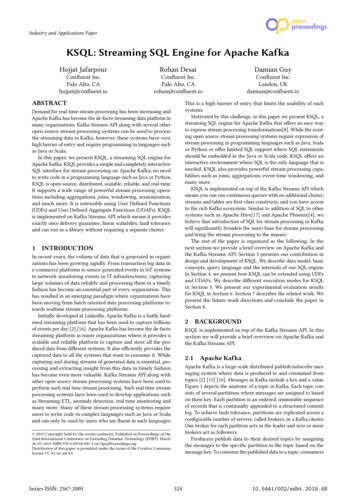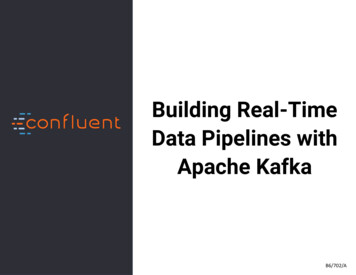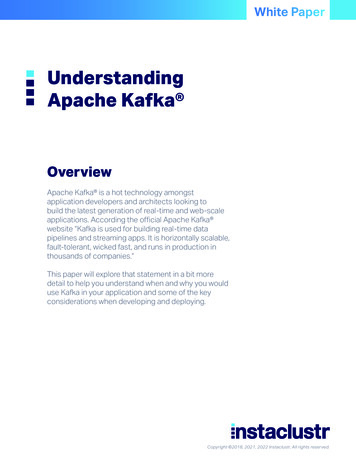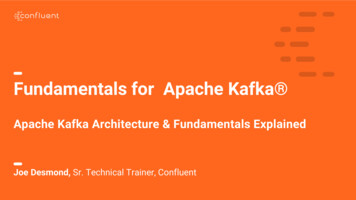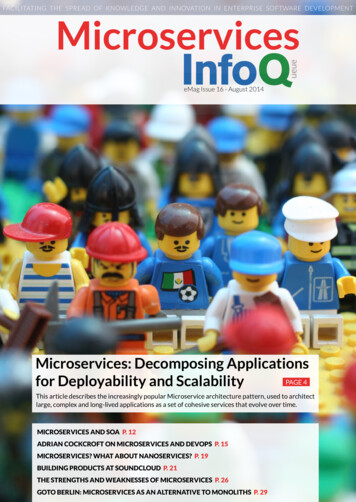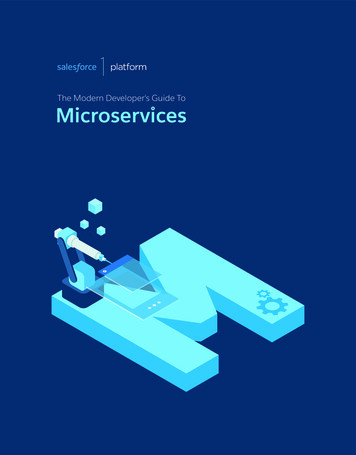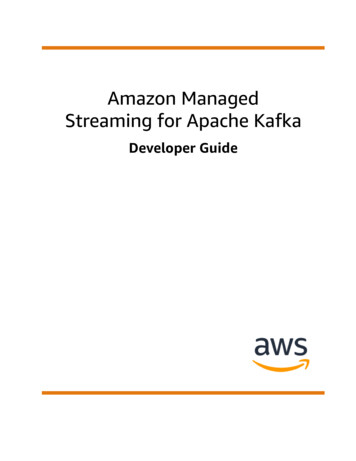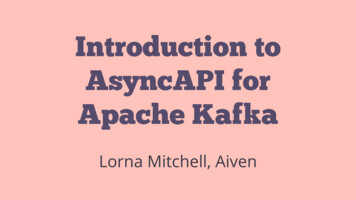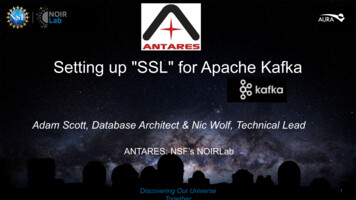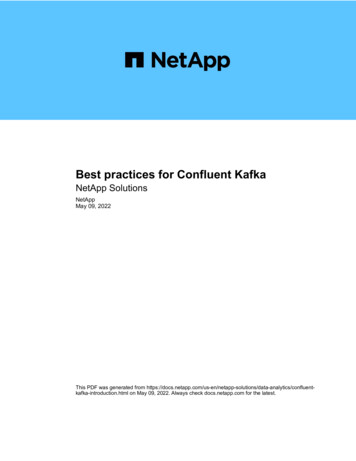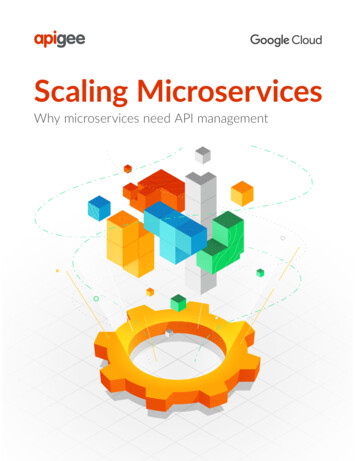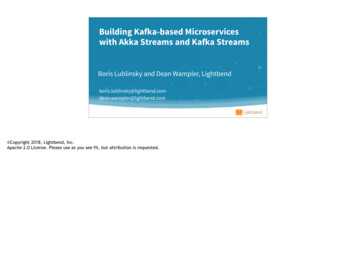
Transcription
Building Kafka-based Microserviceswith Akka Streams and Kafka StreamsBoris Lublinsky and Dean Wampler, @lightbend.com Copyright 2018, Lightbend, Inc.Apache 2.0 License. Please use as you see fit, but attribution is requested.
Overview of streaming architecturesOutline Kafka, Spark, Flink, Akka Streams, Kafka Streams Running example: Serving machine learning models Streaming in a microservice context Akka Streams Kafka StreamsWrap up
About Streaming ArchitecturesWhy Kafka, Spark, Flink, Akka Streams, and Kafka Streams?
Check out these resources:Dean’s bookWebinarsetc.Fast Data Architecturesfor Streaming ApplicationsGetting Answers Now from Data Sets that Never EndBy Dean Wampler, Ph. D., VP of Fast Data EngineeringGet Your Free Copy4! Dean wrote this report describing the whole fast data landscape.! bit.ly/lightbend-fast-data! Previous talks (“Stream All the Things!”) and webinars (such as this one, aming-engine-recording.html) have covered the whole architecture. This session dives into the next level of detail, using Akka Streams and Kafka Streams tobuild Kafka-based microservices
Mesos, YARN, Cloud, Go113 MicroservicesNode.js42ZKZooKeeper ClusterFlink61Ka9a7KaEa Cluster5Akka StreamsKa9a Streams Low ay’s focus: Kafka - the databackplaneREST Akka Streamsand KafkaSocketsStreams rsistenceSQL/NoSQLSpark BatchKafka is the data backplane for high-volume data streams, which are organized by topics. Kafka has high scalability and resiliency, so it's an excellent integration toolbetween data producers and consumers.
Mesos, YARN, Cloud, Go113 MicroservicesNode.jsSockets421FlinkKa9aKaEa ClusterLogs6Akka Streams7Ka9a Streams Low FS10SearchPersistenceSQL/NoSQLSpark BatchBeamRESTZKWhat is Kafka?ZooKeeper ClusterBeamRP
Kafka is a distributed log, storing messages sequentially. Producers always write to the end of the log, consumers can read on the log offset that they want to readfrom (earliest, latest, )Kafka can be used as either a queue or pub subThe main differences are:1. Log is persistent where queue is ephemeral (reads pop elements)2. Traditional message brokers manage consumer offsets, while log systems allow users to manage offsets themselvesAlternatives to Kafka include Pravega (EMC) and Distributed Log/Pulsar (Apache)
Kafka cluster typically consists of multiple brokers to maintain load balance.One Kafka broker instance can handle hundreds of thousands of reads and writes per second and each broker can handle TB (based on the disk size and networkperformance) of messages without performance impact. Kafka broker leader election can be done by ZooKeeper.
A Topic and Its PartitionsKafka data is organized by topicA topic can be comprised of multiple partitions.A partition is a physical data storage artifact. Data in a partition can be replicated across multiple brokers. Data in a partition is guaranteed to be sequential.So, a topic is a logical aggregation of partitions. A topic doesn’t provide any sequential guarantee (except a one-partition topic, where it’s “accidental”).Partitioning is an important scalability mechanism - individual consumers can read dedicated partitions.Partitioning mechanisms - round-robin, key (hash) based, custom. Consider the sequential property when designing partitioning.
Consumer GroupsConsumers label themselves with a consumer group name, and each record published to a topic is delivered to one consumer instance within each subscribing consumer group (compare to queue semantics intraditional messaging). Consumer instances can be in separate processes or on separate machines.
Kafka Producers and ConsumersCode time1.Project overview2.Explore and run the client project Creates in-memory (“embedded”) Kafkainstance and our topics Pumps data into them11We’ll walk through the whole project, to get the lay of the land, then look at the client piece. The embedded Kafka approach is suitable for non-production scenariosonly, like learning ;)
Why Kafka for Connectivity?Before:InternetService 1ServicesService 2ServicesService 3ServicesLog &Other FilesProducersN * M linksConsumersWe’re arguing that you should use Kafka as the data backplane in your architectures. Why?First, point to point spaghetti integration quickly becomes unmanageable as the amount of services grows
Why Kafka for Connectivity?Before:InternetAfter:Service 1ServicesInternetService 1ServicesService 2ServicesService 3ServicesLog &Other FilesProducersService 2ServicesService 3ServicesLog &Other FilesN * M linksConsumersProducersN M linksConsumersKafka can simplify the situation by providing a single backbone which is used by all services (there are of coarse topics, but they are more logical then physicalconnections). Additionally Kafka persistence provides robustness when a service crashes (data is captured safely, waiting for the service to be restarted) - see alsotemporal decoupling, and provide the simplicity of one “API” for communicating between services.
Why Kafka for Connectivity?Kafka: After:Simplify dependencies betweenservicesInternetService 1ServicesService 2Services Improved data consistency Minimize data transmissions Reduce data loss when a servicecrashesService 3ServicesLog &Other FilesProducersN M linksConsumersKafka can significantly improve decoupling (no service specific endpoints, temporal decoupling), It minimize the amount of data send over network, each producer writesdata to Kafka, instead of writing it to multiple consumers. This also improves data consistency - the same data is consumed by all consumers. Extensibility is greatlysimplified - adding new consumers does not require any changes to producers, and provide the simplicity of one “API” for communicating between services.
Why Kafka for Connectivity?Kafka: After:M producers, N consumersInternetService 1Services Improved extensibilityService 2ServicesService 3Services Simplicity of one “API” forcommunicationLog &Other FilesProducersN M linksConsumersKafka can significantly improve decoupling (no service specific endpoints, temporal decoupling), It minimize the amount of data send over network, each producer writesdata to Kafka, instead of writing it to multiple consumers. This also improves data consistency - the same data is consumed by all consumers. Extensibility is greatlysimplified - adding new consumers does not require any changes to producers, and provide the simplicity of one “API” for communicating between services.
3 MicroservicesNode.jsREST42FlinkStreaming Engines:SocketsLogsZKZooKeeper ClusterKa9aSpark,Flink - services to which1KaEa Clusteryou submit work.Large scale,5automatic data partitioning.6Akka Streams7Ka9a Streams Low ini-batchHDFS10SearchPersistenceSQL/NoSQLSpark BatchThey support highly scalable jobs, where they manage all the issues of scheduling processes, etc. You submit jobs to run to these running daemons. They handlescalability, failover, load balancing, etc. for you.
Streaming Engines:Spark, Flink - services to whichyou submit work. Large scale,automatic data partitioning.You have to write jobs, using their APIs, that conform to their programming model. But if you do, Spark and Flink do a great deal of work under the hood for you!
3 MicroservicesNode.jsREST42ZKZooKeeper ClusterFlinkStreaming Frameworks:SocketsLogsKa9aAkka1 Streams, Kafka Streams KaEa Clusterlibraries for “data-centricmicro5services”. Smaller scale, but greatflexibility.DiskDiskDisk6Akka Streams7Ka9a Streams Low S10SearchPersistenceSQL/NoSQLSpark BatchMuch more flexible deployment and configuration options, compared to Spark and Flink, but more effort is required by you to run them. They are “just libraries”, sothere is a lot of flexibility and interoperation capabilities.
Machine Learning and Model Serving:A Quick IntroductionWe’ll return to more details about AS and KS as we get into implementation details.
Serving Machine Learning ModelsA Guide to Architecture, Stream Processing Engines,and FrameworksBy Boris Lublinsky, Fast Data Platform ArchitectGet Your Free Copy20Our concrete examples are based on the content of this report by Boris, on different techniques for serving ML models in a streaming context.
ML Is SimpleDataMagicHappiness21Get a lot of dataSprinkle some magicAnd be happy with results
Maybe Not22Not only the climb is steep, but you are not sure which peak to climbCourt of the Patriarchs at Zion National park
Even If There Are Instructions23Not only the climb is steep, but you are not sure which peak to climbCourt of the Patriarchs at Zion National park
The RealityMeasure/evaluate resultsWe will onlydiscuss thisScoremodelsExportmodelsSet business goalsUnderstand yourdataCreate hypothesisVerify/test 24
What Is The Model?A model is a function transforming inputs tooutputs - y f(x)for example:Linear regression: y ac a1*x1 an*xnNeural network: f (x) K ( i wi g i (x))Such a definition of the model allows for an easy implementation ofmodel’s composition. From the implementation point of view it is justfunction composition25
Model Learning PipelineUC Berkeley AMPLab introduced machine learning pipelines as a graphdefining the complete chain of data transformation.Input Data odeloutputsDataPostprocessingResultsmodel learning pipeline26UC Berkeley AMPLab introduced machine learning pipelines as a graph defining the complete chain of data transformationThe advantage of such approachIt captures the whole processing pipeline including data preparation transformations, machine learning itself and any required post processing of the ML results.Although a single predictive model is shown on this picture, in reality several models can be chained to gather or composed in any other way. See PMML documentationfor description of different model composition approaches.Definition of the complete model allows for optimization of the data processing.Definition of the complete model allows for optimization of the data processing.This notion of machine learning pipelines has been adopted by many applications including SparkML, Tensorflow, PMML, etc.
Traditional Approach to Model Serving Model is code This code has to be saved and then somehow imported intomodel servingWhy is this problematic?27
Impedance MismatchContinually expandingData Scientist toolboxDefined SoftwareEngineer toolbox28In his talk at the last Flink Forward, Ted Dunning discussed the fact that with multiple tools available to Data scientists, they tend to use different tools for solvingdifferent problems and as a result they are not very keen on tools standardization. This creates a problem for software engineers trying to use “proprietary” modelserving tools supporting specific machine learning technologies. As data scientists evaluate and introduce new technologies for machine learning, software engineersare forced to introduce new software packages supporting model scoring for these additional technologies.
Alternative - Model As mentStandardsPortableFormat forAnalytics (PFA)29In order to overcome these differences, Data Mining Group have introduced 2 standards - Predictive Model Markup Language (PMML) and Portable Format for Analytics(PFA), both suited for description of the models that need to be served. Introduction of these models led to creation of several software products dedicated to“generic” model serving, for example Openscoring, Open data group, etc.Another de facto standard for machine learning is Tensorflow, which is widely used for both machine learning and model serving. Although it is a proprietary format, itis used so widely that it becomes a standardThe result of this standardization is creation of the open source projects, supporting these formats - JPMML and Hadrian which are gaining more and more adoption forbuilding model serving implementations, for example ING, R implementation, SparkML support, Flink support, etc. Tensorflow also released Tensorflow java APIs,which are used in a Flink TensorFlow
Exporting Model As Data With PMMLThere are already a lot of export orflow30
Evaluating PMML ModelThere are also a few PMML https://github.com/opendatagroup/augustus31
Exporting Model As Data With Tensorflow Tensorflow execution is based on Tensors and Graphs Tensors are defined as multilinear functions which consistof various vector variables A computational graph is a series of Tensorflow operationsarranged into graph of nodes Tensorflow supports exporting graphs in the form of binaryprotocol buffers There are two different export format - optimized graphand a new format - saved model32
Evaluating Tensorflow Model Tensorflow is implemented in C with a Python interface. In order to simplify Tensorflow usage from Java, in 2017Google introduced Tensorflow Java API. Tensorflow Java API supports importing an exported modeland allows to use it for scoring.33We have a previously-trained TF model on the included “Wine Records” data. We’ll import that model to do scoring.
Additional Considerations – Model Lifecycle Models tend to change Update frequencies vary greatly –from hourly to quarterly/yearly Model version tracking Model release practices Model update process34
The SolutionA streaming system allowing to update models without interruption of execution(dynamically controlled stream).DatasourceData streamStreaming engineMachinelearningModelsourceCurrentmodelModel l modelstorage (Optional)35The majority of machine learning implementations are based on running model serving as a REST service, which might not be appropriate for high-volume dataprocessing or streaming systems, since they require recoding/restarting systems for model updates. For example, Flink TensorFlow or Flink JPPML.
Model Representation (Protobufs)// On the wiresyntax “proto3”;// Description of the trained model.message ModelDescriptor {string name 1; // Model namestring description 2; // Human readablestring dataType 3; // Data type for which this model is applied.enum ModelType { // Model typeModelType modeltype 4;TENSORFLOW 0;oneof MessageContent {TENSORFLOWSAVED 2;// Byte array containing the modelPMML 2;bytes data 5;};string location 6;}}36You need a neutral representation format that can be shared between different tools and over the wire. Protobufs (from Google) is one of the popular options. Recallthat this is the format used for model export by TensorFlow. Here is an example.
Model Representation (Scala)trait Model {def score(input : Any) : Anydef cleanup() : Unitdef toBytes() : Array[Byte]def getType : Long}def ModelFactoryl {def create(input : ModelDescriptor) : Modeldef restore(bytes : Array[Byte]) : Model}37Corresponding Scala code that can be generated from the description.
Side Note: MonitoringModel monitoring should provide information about usage,behavior, performance and lifecycle of the deployed modelscase class ModelToServeStats(name: String,// Model namedescription: String,// Model descriptormodelType: ModelDescriptor.ModelType, // Model typesince : Long,// Start time of model usagevar usage : Long 0,// Number of servingsvar duration : Double 0.0,// Time spent on servingvar min : Long Long.MaxValue, // Min serving timevar max : Long Long.MinValue // Max serving time)38
Queryable StateQueryable state: ad hoc query of the state in the stream. Different thanthe normal data flow.Treats the stream processing layer as a lightweight embeddeddatabase. Directly query the current state of a stream processingapplication. No need to materialize that state to a database, etc. first.MonitoringStateStreamsourceInteractive queriesOther appStreamprocessorStreaming engine39Kafka Streams and Flink have built-in support for this and its being added to Spark Streaming. We’ll show how to use other Akka features to provide the same ability ina straightforward way for Akka Streams.
Microservice All the Things!
s/967703711492423682
A Spectrum of MicroservicesEvent-driven μ-services“Record-centric” μ-servicesRESTDataAPI BrowseModelTrainingInventoryOtherLogicstorage RecordsBy event-driven microservices, I mean that each individual datum is treated as a specific event that triggers some activity, like steps in a shopping session. Each event requires individualhandling, routing, responses, etc. REST, CQRS, and Event Sourcing are ideal for this.Records are uniform (for a given stream), they typically represent instantiations of the same information type, for example time series; we can process them individually or as a group, forefficiency.It’s a spectrum because we might take those events and also route them through a data pipeline, like computing statistics or scoring against a machine learning model (as here), perhapsfor fraud detection, recommendations, etc.
A Spectrum of MicroservicesEvent-driven μ-servicesRESTAPI GatewayOrdersAccountShoppingCartEventsAkka Streams pushes to theright, more data-centric.BrowseInventoryAkka emerged from the left-handside of the spectrum, the worldof highly Reactive microservices. RecordsI think it’s useful to reflect on the history of these toolkits, because their capabilities reflect their histories. Akka Actors emerged in the world of building Reactive microservices, thoserequiring high resiliency, scalability, responsiveness, CEP, and must be event driven. Akka is extremely lightweight and supports extreme parallelism, including across a cluster. However,the Akka Streams API is effectively a dataflow API, so it nicely supports many streaming data scenarios, allowing Akka to cover more of the spectrum than before.
A Spectrum of MicroservicesEmerged from the right-handside.Kafka Streams pushes to theleft, supporting many eventprocessing scenarios.Events“Record-centric” storageRecordsKafka reflects the heritage of moving and managing streams of data, first at LinkedIn. But from the beginning it has been used for event-driven microservices, where the “stream”contained events, rather than records. Kafka Streams fits squarely in the record-processing world, where you define dataflows for processing and even SQL. It can also be used for eventprocessing scenarios.
Akka Streams
A library Implements Reactive Streams. http://www.reactive-streams.org/ Back pressure for flow control46See this website for details on why back pressure is an important concept for reliable flow control, especially if you don’t use something like Kafka as your “nearinfinite” buffer between services.
unded queue47Bounded queues are the only sensible option (even Kafka topic partitions are bounded by disk sizes), but to prevent having to drop input when it’s full, consumerssignal to producers to limit flow. Most implementations use a push model when flow is fine and switch to a pull model when flow control is needed.
ConsumerEvent/DataStreamConsumer48And they compose so you get end-to-end back pressure.
Part of the Akka ecosystem Akka Actors, Akka Cluster, Akka HTTP, AkkaPersistence, Alpakka - rich connection library like Camel, but implements ReactiveStreams Commercial support from Lightbend49Rich, mature tools for the full spectrum of microservice development.
A very simple example to get the “gist” 50
import akka.stream.import akka.stream.scaladsl.import akka.NotUsedimport akka.actor.ActorSystemimport scala.concurrent.import scala.concurrent.duration.implicit val system ActorSystem("QuickStart")implicit val materializer ActorMaterializer()val source: Source[Int, NotUsed] Source(1 to 10)val factorials source.scan(BigInt(1)) ( (acc, next) acc * next )factorials.runWith(Sink.foreach(println))51This example is in .sc
import akka.stream.import akka.stream.scaladsl.import akka.NotUsedimport akka.actor.ActorSystemimport scala.concurrent.import scala.concurrent.duration.Imports!implicit val system ActorSystem("QuickStart")implicit val materializer ActorMaterializer()val source: Source[Int, NotUsed] Source(1 to 10)val factorials source.scan(BigInt(1)) ( (acc, next) acc * next )factorials.runWith(Sink.foreach(println))52This example is in .sc
import akka.stream.import akka.stream.scaladsl.import akka.NotUsedimport akka.actor.ActorSystemimport scala.concurrent.import scala.concurrent.duration.implicit val system ActorSystem("QuickStart")implicit val materializer ActorMaterializer()Initialize and specifynow the stream is“materialized”val source: Source[Int, NotUsed] Source(1 to 10)val factorials source.scan(BigInt(1)) ( (acc, next) acc * next )factorials.runWith(Sink.foreach(println))53This example is in .sc
import akka.stream.import akka.stream.scaladsl.import akka.NotUsedimport akka.actor.ActorSystemimport scala.concurrent.import scala.concurrent.duration.implicit val system ActorSystem("QuickStart")implicit val materializer ActorMaterializer()Create a Source ofInts. Second type isfor “side band” data(not used here)val source: Source[Int, NotUsed] Source(1 to 10)val factorials source.scan(BigInt(1)) ( (acc, next) acc * next )factorials.runWith(Sink.foreach(println))54This example is in .sc
import akka.stream.import akka.stream.scaladsl.import akka.NotUsedimport akka.actor.ActorSystemimport scala.concurrent.import scala.concurrent.duration.implicit val system ActorSystem("QuickStart")implicit val materializer ActorMaterializer()Scan the Source andcompute factorials,with a seed of 1, oftype BigIntval source: Source[Int, NotUsed] Source(1 to 10)val factorials source.scan(BigInt(1)) ( (acc, next) acc * next )factorials.runWith(Sink.foreach(println))55This example is in .sc
import akka.stream.import akka.stream.scaladsl.import akka.NotUsedimport akka.actor.ActorSystemimport scala.concurrent.import scala.concurrent.duration.implicit val system ActorSystem("QuickStart")implicit val materializer ActorMaterializer()Output to a Sink,and run itval source: Source[Int, NotUsed] Source(1 to 10)val factorials source.scan(BigInt(1)) ( (acc, next) acc * next )factorials.runWith(Sink.foreach(println))56This example is in .sc
import akka.stream.import akka.stream.scaladsl.import akka.NotUsedimport akka.actor.ActorSystemimport scala.concurrent.import scala.concurrent.duration.implicit val system ActorSystem("QuickStart")implicit val materializer ActorMaterializer()A source, flow, andsink constitute agraphval source: Source[Int, NotUsed] Source(1 to 10)val factorials source.scan(BigInt(1)) acc * next )SourceFlow ( (acc, next) Sinkfactorials.runWith(Sink.foreach(println))57The core concepts are sources and sinks, connected by flows. There is the notion of a Graph for more complex dataflows, but we won’t discuss them further
This example is included in the project: .sc To run it (showing the different prompt!): sbtsbt:akkaKafkaTutorial project akkaStreamsCustomStagesbt:akkaStreamsCustomStage consolescala :load .sc58The “.sc” extension is used so that the compiler doesn’t attempt to compile this Scala “script”. Using “.sc” is an informal convention for such files.We used yellow to indicate the prompts (3 different shells!)
Using Custom StageCreate a custom stage, a fully type-safe way to encapsulate newfunctionality. Like adding a new “operator”.Source 1AlpakkaStream 1Flow 1Stream 1Custom stage –model servingSource 2AlpakkaResults Streamam 2StreStream 2Flow 259Custom stage is an elegant implementation but doesn’t scale well to a large number of models. Although a stage can contain a hash map of models, all of theexecution will be happening at the same place
Using a Custom StageCode time1. Run the client project (if not already running)2. Explore and run akkaStreamsCustomStageproject60Custom stage is an elegant implementation but not scale well to a large number of models. Although a stage can contain a hash map of models, all of the executionwill be happening at the same place
Exercises!We’ve prepared some exercises. We may nothave time during the tutorial to work onthem, but take a look at the exercise branch inthe Git project (or the separate X.Y.Z exercisedownload).To find them, search for “// Exercise”. Themaster branch implements the solutions formost of them.61
Other Production Concerns62
Scale scoring with workers androuters, across a cluster Persist actor state with tatefulLogicModel ServingPersistence Connect to almost anything withAlpakka for production monitoring, etc.actor icAlpakkaAkka ClusterDataAlpakka Lightbend Enterprise SuiteAlpakkaRouterAlpakkaAkka ClusterstorageFinalRecordsModelTrainingHere’s our streaming microservice example adapted for Akka Streams. We’ll still use Kafka topics in some places and assume we’re using the same implementation forthe “Model Training” microservice. Alpakka provides the interface to Kafka, DBs, file systems, etc. We’re showing two microservices as before, but this time running inAkka Cluster, with direct messaging between them. We’ll explore this a bit more after looking at the example code.
Improve Scalability for Model ServingUse a router actor to forward requests to the actorresponsible for processing requests for a specificmodel type.Source 1AlpakkaStream 1Flow 1Stream elactorservingactorModelservingrouterSource 2AlpakkaStream 2Flow 2Stream 264We here create a routing layer: an actor that will implement model serving for specific model (based on key) and route messages appropriately. This way our systemwill serve models in parallel.
Akka Streams with Actors and PersistenceCode time1. While still running the client project 2. Explore and run akkaActorsPersistent project65Custom stage is an elegant implementation but not scale well to a large number of models. Although a stage can contain a hash map of models, all of the executionwill be happening at the same place
More Production Concerns66
Using Akka ClusterTwo levels ofscalability: Kafka partitionedtopic allow toscale listenersaccording to theamount ofpartitions. Akka clustersharing allows tosplit modelserving actorsacross clusters.JVMSource 1AlpakkaStream 1Flow 1ModelservingrouterKafka ClusterSource 2AlpakkaStream 2Source 1AlpakkaStream 1Flow 2Flow 1ModelservingrouterSource 2AlpakkaStream 2Flow 2Stream elactorservingactorStream 2Stream ModelactorservingactorStream 2Akka Cluster67A great article ing-sharding-from-akka-cluster/ goes into a lot of details on both implementation and testing
Go Direct or Through Kafka?ModelServingOtherLogicAlpakkaAlpakkaAkka Cluster Extremely low latency Minimal I/O and memoryoverhead No marshaling overheadvs.ModelServingOtherLogic?ScoredRecords Higher latency (including queuedepth) Higher I/O and processing(marshaling) overhead Better potential reusabilityDesign choice: When is it better to use direct actor-to-actor (or service-to-service) messaging vs. going through a Kafka topic?
Go Direct or Through Kafka?ModelServingOtherLogicAlpakkaAlpakkaAkka Clustervs.ModelServingOtherLogic?ScoredRecords Reactive Streams backpressure Very deep buffer (partitionlimited by disk size) Direct coupling betweensender and receiver, butindirectly through a URL Strong decoupling - Mproducers, N consumers,completely disconnectedDesign choice: When is it better to use direct actor-to-actor (or service-to-service) messaging vs. going through a Kafka topic?
Kafka StreamsSame sample use case, now with Kafka Streams
Kafka Streams Important stream-processing concepts, e.g., Distinguish between event time and processing time Windowing support. For more on these concepts, see Dean’s book ;) Talks, blog posts, writing by Tyler Akidau71There’s a maturing body of thought about what streaming semantics should be, too much to discuss here. Dean’s book provides the next level of details. See Tyler’swork (from the Google Apache Beam team) for deep dives.
Kafka Streams KStream - per-record transformations KTable - key/value store of supplementaldata Efficient management of application state72There is a duality between streams and tables. Tables are the latest state snapshot, while streams record the history of state evolution. A common way to implementdatabases is to use an event (or change) log, then update the state from
Outline Overview of streaming architectures Kafka, Spark, Flink, Akka Streams, Kafka Streams Running example: Serving machine learning models Streaming in a microservice context Akka Streams Kafka Streams Wrap up
